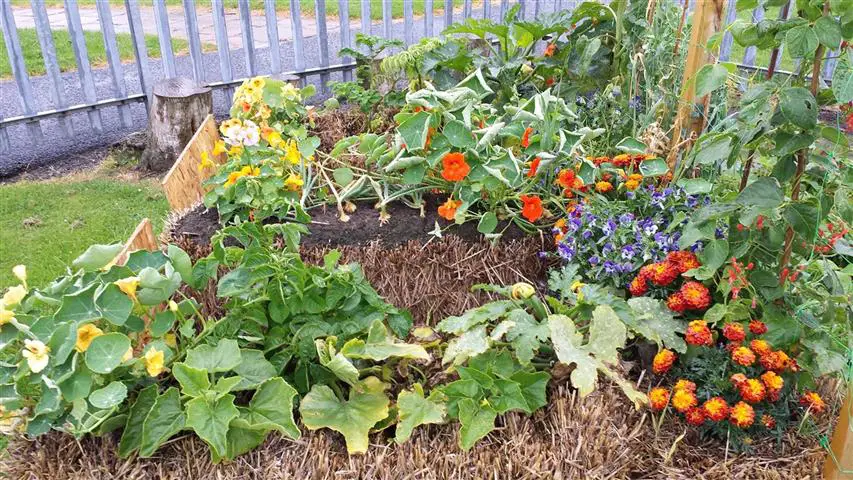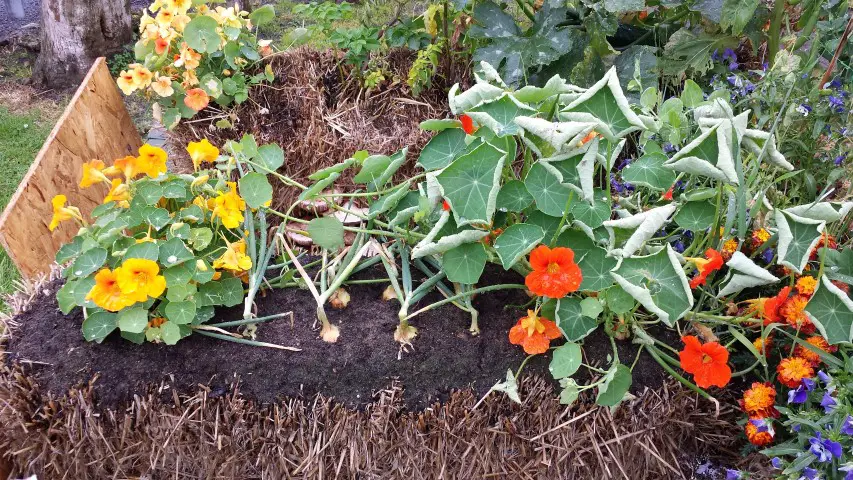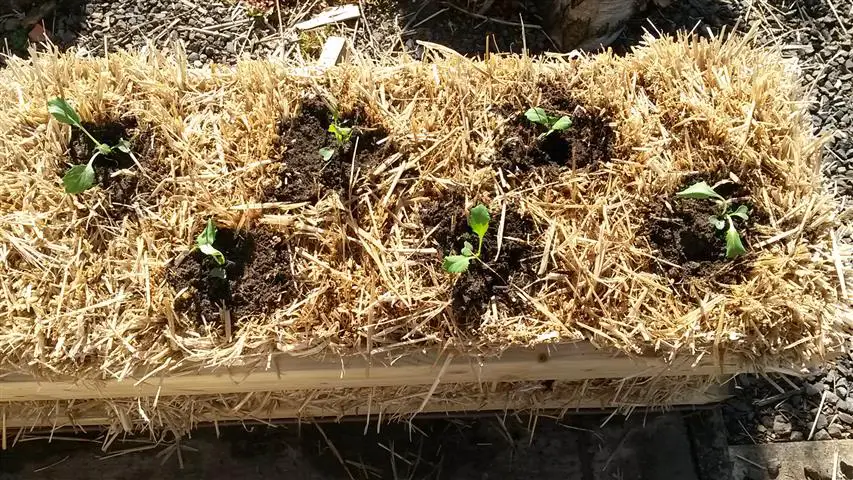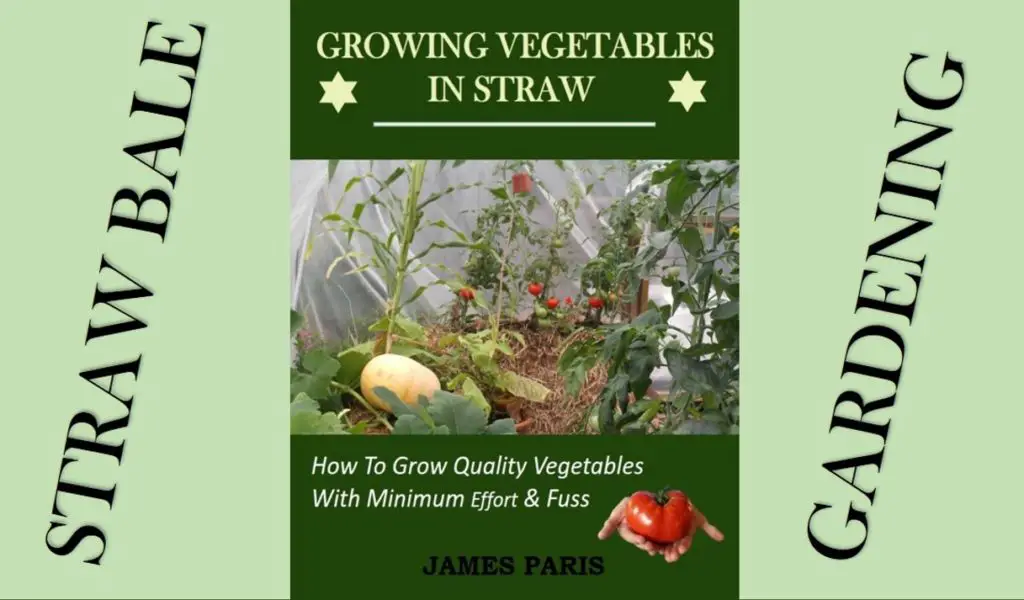Companion planting alongside vegetables is a well-known concept, and one that works very well in the confined area that we have in a bale of straw, or indeed a straw bale garden that may include many straw bales.
Growing vegetables alongside their perfect companions not only improves your chances of a good healthy crop, it can also look great!
The fact is that once a straw bale has been down a few months, it can start to look just a little bedraggled and unkempt – this is just the nature of the decomposition process involved in straw bale gardening.

However as you may see from the pictures, add a few flowers and the whole garden suddenly looks quite attractive – and a real point of conversation with the neighbours it has to be said.
All in all I consider that there are at least 4 reasons why anyone with a straw bale garden should consider the concept of Companion planting whether in a straw bale or traditional garden.
- Aesthetic reasons – flowers amongst the vegetables just looks good and detracts from the decaying straw bale.
- Practical reasons – Good companions like peas and beans can add nitrogen straight into the bale, thereby feeding other nitrogen-hungry vegetables.
- Not just good-looking, there are many flowers that are edible and make an excellent addition to the salad bowl or even sprinkled around the table!
- Insect protection – chives or onions planted around the carrots help disguise the carrot smell from the carrot-fly. And dwarf marigolds planted in the straw bale attract the hoverfly, and the hoverfly larvae feed on aphids.
With al that said, what are some good and bad companion plants for vegetables – I’m glad you asked! Here is a chart extracted from my Amazon book on Companion planting.
on Companion planting.
Good and Bad Companions for vegetables
VEGGIES | GOOD COMPANION | BAD COMPANION |
| Asparagus | tomato, parsley, basil | onions, garlic, potatoes |
| Beans | beetroot, cabbage, celery, carrot, cucumber, corn, squash, pea’s, potatoes, radish, strawberry. | garlic, shallot or onions |
| Beets | broccoli, brussels sprouts, bush beans, cabbage, cauliflower | charlock, field mustard, pole beans |
| Cabbage | cucumber, potato, onion, spinach, celery. | strawberries |
| Carrots | beans, peas, onions, leeks, lettuce, tomato, chives, and radish | dill |
| Celery | bean, tomato and cabbage family | corn, Irish potato and aster flowers |
| Corn | potato, pumpkin, squash, tomato, cucumber | tomatoes |
| Cucumber | cabbage, beans, radish, tomato | late potatoes |
| Eggplant | beans, peas, spinach, tarragon, thyme | |
| Garlic | cabbage, cane fruits, fruit trees, tomatoes | peas, beans |
| Leeks | Carrots, celery, onions | legumes |
| Lettuce | carrot, beet, onion, and strawberry | cabbage family |
| Melon | pumpkin, radish, corn, and squash | |
| Onions | cabbage family, beet, tomato, pepper, strawberry, and chard | beans, peas |
| Parsley | asparagus, carrot, tomato and corn | mint |
| Peas | beans, carrot, corn and radish | garlic leeks, onions, shallots |
| Peppers | tomato, eggplant, carrot and onion | fennel, kohlrabi |
| Potatoes | bean, cabbage, squash and peas | apples, cherries, cucumbers, pumpkins, sunflowers, tomatoes |
| Pumpkin | melon eggplant and corn | potato, raspberry |
| Radish | carrot, cucumber, bean, pea, melon | hyssop |
| Squash | melon, pumpkin, beans, cucumber, onion | potato, tomato |
| Strawberry | bean, lettuce, onion and spinach | cabbage, broccoli, Brussels sprouts |
| Tomatoes | celery, cucumber, asparagus, parsley, pepper and carrot | fennel, kohlrabi, potatoes |
We can see from this chart that there is a huge number of good and bad companion vegetables and flowers that you can use in a straw bale garden to increase its productivity – and make it look good.

The edible flowers that I particularly like to use in straw bale gardens include the following.
- Flowering chive plants
- Nasturtium
- Dwarf marigold flowers
- Viola flowers
- Cornflower
- Honeysuckle
- Rose
- Scented Geranium
These are all plants that can be grown alongside your vegetables – and added to the salads or main dishes you prepare with them.
So not only do these flowers look good on your straw bale – they also look good on the plate of food.

How to plant in a straw bale
Before you plant vegetables or flowers in a straw bale you first of all have to condition the bale – a process more fully described in this article – This is basically preparing the bale by feeding it with a nitrogen-rich fertilizer (lawn fertilizer is best) for about 3-4 weeks prior to planting.
Considering this done, you have to pull out a pot-sized area of straw and fill this with a good compost mix – really press it in with your fingers so that all the little gaps are filled.
The size of the hole depends on what exactly you are planting but on average a 6-inch diameter hole at about 6 inches deep will do most plants.
Your seedling is then put into the soil and watered just like any other seedling you would grow.
The reasoning behind this is the compost will give the young plant all the nutrients it needs until the plant matures and the root system is being fed by the composting bale.
What is the difference between straw and hay bales?
Some people choose to grow in hay bales rather than straw, and there is at least 1 compelling reason for that choice.
A hay bale is made up of compressed grass that has been especially harvested for its nutritional value for feeding livestock.
Straw bales are predominantly the discarded remnants of barley, oats, or wheat crops, and the straw is traditionally used for bedding livestock.

There is zero nutritional value in a straw bale which is basically just carbon or ‘brown’ material if added to compost for example.
Straw bales do not have problems with weeds growing in them.
Hay bales can be full of grass seeds that will sprout as soon as the watering starts.
The 1 advantage that hay bale gardening has over straw bales however, is that since hay is already packed with nitrogen and other nutrients, there is no need for the conditioning process that straw needs.
There is also no need to use chemical fertilizers, so it is inherently a more organic method of growing vegetables.
Summary
No matter whether you choose to grow your veggies in straw or hay, the fact is that they both look and operate a lot better with the correct companion plants planted in them.
Check out the chart above as often as you need to for the best veggie companions for your vegetables, and also remember the flowers not only for the beauty aspect but for the protection they offer your vegetables.
Looking for more info on Companion planting? Then check out the Amazon book with all the information you need to choose the best companions for your straw bale garden veggies.
with all the information you need to choose the best companions for your straw bale garden veggies.


